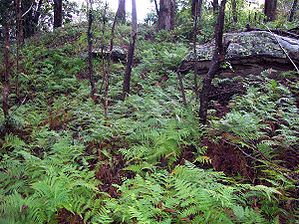- Calochlaena dubia
-
False Bracken 
False bracken at Chatswood West, Australia Scientific classification Kingdom: Plantae Division: Pteridophyta Class: Pteridopsida Order: Cyatheales Family: Dicksoniaceae Genus: Calochlaena Species: C. dubia Binomial name Calochlaena dubia
(R.Br.) M.D.Turner & R.A.WhiteSynonyms Culcita dubia R.Br.
Calochlaena dubia, commonly known as soft bracken, false bracken, common ground fern or rainbow fern, is a small Australian fern in the treefern family Dicksoniaceae. It is very common within its range, and often seen growing under eucalyptus forest, often on the poorer quality soils.[1] It is an easy plant to grow in the garden.
Contents
Taxonomy
One of the many plants described by Scottish botanist Robert Brown in 1810, with the name Davallia dubia,[2] it gained its current name with the new genus Calochlaena described in 1988.[3] The genus name is derived from the Ancient Greek kalos "beautiful" and chlaina "cloak", and refers to the soft hairs on the species,[4] while the species name dubia is the Latin dubious. It was known for many years as Culcita dubia,[5] before the genus Calochlaena was split out in 1988.[6]
The true brackens belong to the family Dennstaedtiaceae.[7]
Description
The fronds arise from the thick brown haired rhizomes and are anywhere from 0.4 to 1.5 m in height.[1] The foliage is a more yellow green colour, in contrast to the darker shiny green of bracken (Pteridium esculentum). The stipe changes from dark brown, through reddish- to yellow brown, and is covered with soft brown hairs. The fronds are triangular overall and tripinnate-pinnatifid in shape. The sori occur near the margin.[8]
Distribution and habitat
Calochlaena dubia is found as an understory plant in open forests and rainforests in eastern Australia, from Queensland, through New South Wales and Victoria into Tasmania. It can form large banks or swathes.[8]
Cultivation
Well suited to the garden, Calochlaena dubia is an easy plant to grow.[9] In fact, it must be kept in check by cutting the rhizomes and given plenty of room. It does well on clay soils.[5]
References
- ^ a b "Calochlaena dubia". PlantNET - NSW Flora Online. http://plantnet.rbgsyd.nsw.gov.au/cgi-bin/NSWfl.pl?page=nswfl&lvl=sp&name=Calochlaena~dubia. Retrieved 2010-07-09.
- ^ "Davallia dubia R.Br.". Australian Plant Name Index (APNI), IBIS database. Centre for Plant Biodiversity Research, Australian Government. http://www.anbg.gov.au/cgi-bin/apni?taxon_id=27385.
- ^ "Calochlaena dubia (R.Br.) M.D.Turner & R.A.White". Australian Plant Name Index (APNI), IBIS database. Centre for Plant Biodiversity Research, Australian Government. http://www.anbg.gov.au/cgi-bin/apni?taxon_id=45283.
- ^ "Calochlaena". Australian Plant Name Index (APNI), IBIS database. Centre for Plant Biodiversity Research, Australian Government. http://www.anbg.gov.au/cgi-bin/apni?taxon_id=4461.
- ^ a b Eliot, Rodger W. & Jones, David L. (1984). "Ce-Er". In Eliot, Rodger W. & Jones, David L.. Encyclopaedia of Australian Plants suitable for cultivation. 3. Lothian Publishing. p. 130. ISBN 0-85091-167-2.
- ^ Richard A. White and Melvin D. Turner (1988). "Calochlaena, a New Genus of Dicksonioid Ferns". American Fern Journal (3): 86–95.
- ^ "Pteridium". Australian Plant Name Index (APNI), IBIS database. Centre for Plant Biodiversity Research, Australian Government. http://www.anbg.gov.au/cgi-bin/apni?taxon_id=2706.
- ^ a b Fairley A, Moore P (2000). Native Plants of the Sydney District:An Identification Guide (2nd ed.). Kenthurst, NSW: Kangaroo Press. p. 34. ISBN 0-7318-1031-7.
- ^ "Calochlaena dubia (DICKSONIACEAE) False Bracken". Save or Waterways Now. 2008. http://www.sown.com.au/01_cms/details_pop.asp?ID=116. Retrieved 9 July 2010.
Categories:- Dicksoniaceae
- Fern species
- Flora of New South Wales
- Flora of Queensland
- Flora of Tasmania
- Flora of Victoria (Australia)
- Garden plants
Wikimedia Foundation. 2010.

